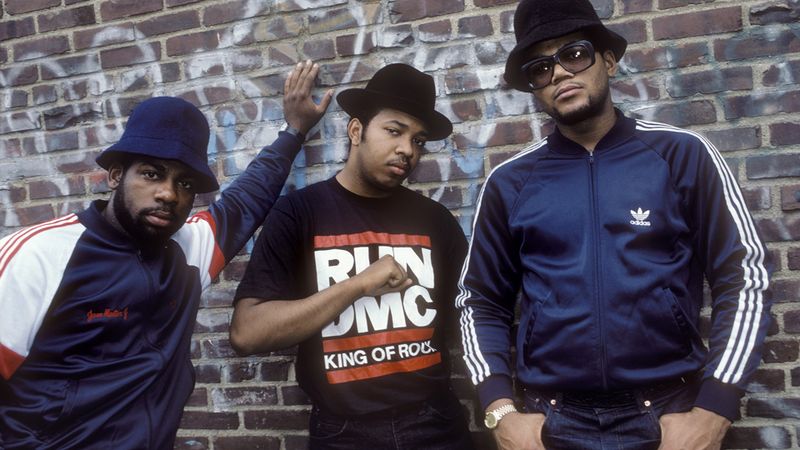THE JOURNAL

Run-DMC (Jam Master Jay, Mr Joseph Simmons and Mr Darryl “DMC” McDaniels) in Hollis Queens, New York, 1986. Photograph by Ms Ebet Roberts/ebetroberts.com
In 2016, the idea of a rapper working with a big brand is more synonymous with hip-hop than a Technics turntable. But that wasn’t the case when adidas and Run-DMC came together in the late 1980s; the group’s single “My Adidas” was released on 29 May 1986, 30 years ago this week.
For all its importance, it’s not the greatest record by the trio from Queens, New York City. Taken from the bestselling Raising Hell LP, it’s a skeletal, scratch-heavy, braggadocious homage to German sportswear that reuses a sample from a couple of years prior. But while it seems like a piece of paid promo, this was a strictly self-funded love letter. Messrs Joseph Simmons, Darryl McDaniels and Jam Master Jay really, really liked their adidas Superstars. Still, the masterplan came soon after.
By the time Run-DMC released their first single in 1983, the adidas Superstar was an old basketball shoe, originally handed to players in 1969. The way Run-DMC wore their Superstars was striking, but they didn’t invent the look. The combination of sneakers without laces (a nod to prison, where they were removed to prevent inmates hanging themselves with them), black Lee jeans, leather goose-down jackets, Cazal glasses and gold rope chains had long been the look of New York hustlers. But as earlier popular artists like Grandmaster Flash and the Furious Five were pushed by their labels into wearing flamboyant, shiny, post-disco gear, Run-DMC would take the street look mainstream.
As revealed by Mr McDaniels in the 2005 documentary Just For Kicks, “My Adidas” originated as a retaliation to an anti-sneaker novelty song called “Felon Shoes”, recorded to discourage kids from aping the stylings of prison inmates. The Run-DMC track and the Raising Hell LP had an accompanying tour that took them and their three-stripe shoe message worldwide. A co-manager of the group, future Def Jam honcho Mr Lyor Cohen, saw the potential to get an endorsement and brought adidas executive Mr Angelo Anastasio to witness a moment when the rappers urged the audience to hold up their sneakers as “My Adidas” was performed. At the Madison Square Garden leg of the tour on 19 July 1986, more adidas executives watched those aloft shoes. Along with Mr Cohen’s brokering and a video in which the group made a brief a capella performance to adidas and then shouted “GIVE US A MILLION DOLLARS!”, this resulted in a then-unprecedented for any musician – let alone a hip-hop act – $1m dollar endorsement deal.

The crowd at a Run-DMC gig in Philadelphia, US, c.1980s. Photograph by Mr Lawrence Watson/PYMCA
That arrangement would lead to some copycat lyrical name checks in a bid for cheques. Heavy D and the Boyz fished for sponsorship with Nike in 1987, while Queensbridge’s MC Shan allied himself with Puma and used shoe talk to dismiss his rap rival LL Cool J, who signed with hip-hop-centric upstart sneaker company Troop. Harlem’s Doug E Fresh had, with a flamboyance typical of that borough, long favoured high-end sneakers from Swiss brand Bally, and there was a relatively good-natured beef between his Get Fresh Crew and Run-DMC as evidenced by the “My Adidas” lyrics, “We started in the alley, now we chill in Cali, and I won’t trade my adidas for no beat-up Ballys.”
After Superstar sales hit close to half a million pairs in that same year, adidas rolled out an entire Run-DMC line, complete with sponsored tours. There were sweatshirts and tees dedicated to the Kings from Queens, plus leather tracksuits with eye-watering price tags.
By 1988, four special Run-DMC shoes had been released. The high-top Eldorado and Fleetwood, plus the low-top Brougham, were named after the group’s favourite cars, while the Ultrastar was a take on the Superstar with an elasticated tongue for easy laceless wear. Adidas would also put its name to Run-DMC’s underperforming movie, a violent 1988 thriller called Tougher Than Leather, released to coincide with an overlooked album of the same name.

Run-DMC gig at Hammersmith Odeon, London, 1986. Photograph by Mr David Corio/Getty Images
By this point, the legacy was cemented and boundaries had been broken. But as the Superstar’s popularity faded, the inevitable overstock was discovered by buyers for seminal London retailers like Duffer of St George who, on a wave of rare groove and jazz-infused clubbing, would fuel a hunger for “old school”. Noting an interest in archive pieces, adidas would respond with an early iteration of its Originals line around 1992 ahead of the launch of the bigger — and colossally successful — adidas Originals brand in 2001.
The Run-DMC/adidas hook-up represented an era when both partners shed their stereotypes — Germanic conservatism was discarded when it came to embracing a rebel art form, while the artists themselves, after years of MCs making a pittance with crooked contracts, reiterated how valuable their brand was and rebutted assumptions that they were part of a fly-by-night youth culture. It was here that sportswear brands realised that the world beyond sport was there for the taking, and that collaborations — from designers, artists, actors and smaller, nimbler brands — could take them to places that they couldn’t go alone. In turn, hip-hop culture learnt that there were infinite possibilities, and profits, in corporations keen for credibility in a new world. Not bad for something instigated by a dusted street corner epiphany.
The celebrities featured in this story are not associated with and do not endorse MR PORTER or the products shown